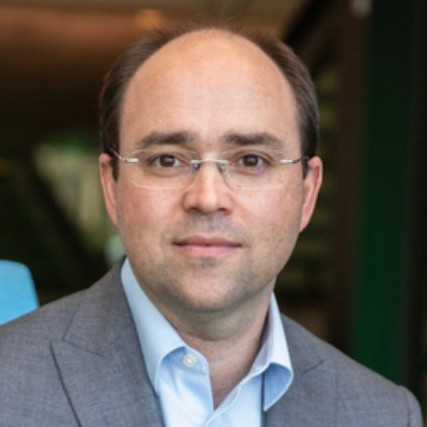Sean Riley: You are listening to Unpacked with PMMI, where we share the latest packaging and processing industry insights, research, and innovations to help you advance your business. Hi, and welcome to Unpacked with PMMI. I'm your host, Sean Riley. In this episode, we sit down with Schneider Electric Senior Vice President of Industrial Automation Business Andre Marino to discuss how manufacturers can adapt to current workforce challenges. He highlights embracing new technology, managing change, and empowering both seasoned and emerging workers to drive long-term success. Let's have a listen.
So with all the fancy introductions out of the way, welcome to the podcast, Andre.
Andre Marino: Thank you, Sean. It's nice to have this opportunity to talk to you.
Sean Riley: Oh, the pleasure is all ours, and we're very happy to have you with us. So I've read that the median age in manufacturing is over 44, which is way higher than workers in other industries and workers at large. So I guess what's driving this talent shortage that's particular to manufacturing? And is there any kind of precedent for it? Have we seen anything like this before?
Andre Marino: I think we can say that's a unique situation in history, because we have many cycles of technology changing and people needing to adapt to new environments and et cetera. It's a new element here, the pace of the change, and how much is changing at the same time. Because we not only have many new technologies coming to the shop floor, but also at the speed at which these things are coming to the shop floor, it's unprecedented. So in that sense, yes, it's unique. And with the new set of skills required, it creates that new dynamic.
So there are multiple angles to it. The first one that we need to recognize is that automation complements what we've been doing in terms of achieving more productivity, being more competitive, et cetera. It's not a replacement for labor. Because if it's either automation or people, you also create a bad dynamic. So I think that's important recognition.
The second one is the fact that companies are locked into the past with the technology they use. So when there are too many silos on technology, you also put yourself in a tougher spot because the pool of talent is reduced. So adopting open standards and software-defined automation helps as well to enlarge the pool of people. And these people, guess what, they are the younger generation, because the younger generation is coming with those kinds of skills. They're coming with software skills, they're coming with AI. They're much more open to technology. So when you adopt open standards, you drive automation, understanding that's not to replace people, but also to enable companies to attract new talent. You have a win-win combination. So I think that companies that are addressing the problem that way are succeeding, and they're just increasing their advantage.
Sean Riley: That makes complete sense. The workers are skewing older. How do companies make sure that those workers who have been there a long time are not walking out the door with all of the industry knowledge? Is there some way to facilitate the transfer between the incoming workforce and that workforce that's aging out?
Andre Marino: I think it starts with proper workforce planning and strategic workforce planning, so you understand what you have in your hands in terms of human capital and knowledge, and when they retire. So you need a proper plan, so you have a strategy for that.
Today, we have technology available that one can actually train the software and put sequences of all the knowledge that they have in order to support new people coming, so they can be trained. So we apply that technology in many fields, from oil and gas to manufacturing sites, and it works pretty well. And that works not only in that situation, but also when you bring a big contingent of people and you need to train them in a new process, maybe it's a dangerous process to be trained. So it serves, I think, both sides of the equation. Planning is super important to understand what skills you need and capabilities that you need to maintain, and how you develop those.
Sean Riley: Is there any way, as people are leaving, to get the newer people with them immediately to tap into that knowledge?
Andre Marino: It's a matter of leadership also to incentivize, "Hey, you have your legacy for many years you were working here, it would be great if you continue your journey now transferring the knowledge to a new generation that's coming, that's just going to build on top of what you have been doing for so many years."
And I think that's also about how we communicate from leadership to our people and the importance of knowledge transfer. And make it practical as well, either by adopting technology or allowing people to have an overlap and time to learn. So it's possible, and it just requires us leaders and the community to talk about it and not to be afraid of discussing the topic. Because it's a pretty important topic. We have in the US by 2033, almost 3.8 million jobs that open in manufacturing. So it's a super important topic.
Sean Riley: Any discussion has to be on the table upfront when you're dealing with a crisis that's that big.
Andre Marino: Exactly. Yeah. Avoiding the conversation, I think, is the worst situation. So we can't avoid it and we need to start today, for sure.
Sean Riley: Okay. So there are all these new technologies that are coming constantly, and you need to be able to A, train people who have already been there in it. And B, make sure the people you're bringing on board are aware of it and can adapt to it. But how about from a business and an operations standpoint? How do you make sure that you're not disrupting downtime? So how do you implement these new technologies and make sure that everybody's up to skill without disrupting business, without disrupting your business operations?
Andre Marino: Yeah. How do you use the best of what we have available in the market, get the new skill set that you need, but continue to operate? And the first, I would say, start investing in new technology. The risk of over-investing in technology is much less than not investing and being left behind. Now, it's important to start by understanding what's the problem you're trying to solve for. A lot of people get stuck in pilots, not because the technology's not available or because they don't have people for that, it's because they're not even understanding what they're trying to solve. So proper planning, a proper investment and be upfront in doing that, helps in the process.
So if you do proper planning, you map your skills and capabilities, and you put them to work, it's going to get you good results. And then the third is the element of change. How do you address change management? And that's to your point, how you do all this without disrupting everything. We discussed it in the beginning that people are afraid of being replaced by automation, so that needs to be addressed.
But there's this notion of things when we start in change management, something people say initially is a crazy idea, then people say it's dangerous, and then it becomes obvious. When we were kids, people said, "Don't meet people online and never get into a car with a stranger." So imagine when you got the first Uber that was like, "Wow, what is that?" And so, leading with change management is also an integral part of the situation where you put new technology, you get the right people, but don't underestimate the change management piece of it, which is to communicate, to explain why. And instead of making people fear technology, they embrace technology.
Sean Riley: Interesting. You're putting all this investment and this time into it, but you have to reframe the idea that this is going to be completely painful. You have to look at it as these are things we're doing to improve it. Are there other tips or ways that you can think of that can help people reframe that idea that, yes, this is going to be challenging to implement all this change, but we need to look at it as a positive because this is how it's going to help us down the road?
Andre Marino: Yeah. And I think that's the number one question, which is to sell what we are trying to achieve. What's the problem that we are solving, that technology and changes will help us to solve, that you cannot do just by manually doing whatever you are doing today? So explaining that is super important.
And I like to use the example of our own factory in Lexington, Kentucky. Schneider operates more than 200 factories around the globe. In the US we have more than 20 manufacturing facilities. So we go there and say, "How can we modernize the factory and put it up to speed to a place where it's called a lighthouse factory by the World Economic Forum?"
So imagine you have a very old factory that, for sure, if you don't use new technology and if you don't change the way you're doing things, you're not going to be competitive in the future. So we had to explain why we were doing this.
A good example of how we manage the people side, the human factor, is that we have an operator that's there for more than 40 years. He was not even carrying an iPhone, and now he's operating one of the most sophisticated factories in the world.
Sean Riley: Wow.
Andre Marino: It's a lighthouse factory nominated by the World Economic Forum, and we don't have thousands of them. So it's about, sure, explaining what we are doing, and also make it easier for the operators that are there to learn new skills. So it's a combination of planning, process, education of people, and in the end, good change management that will lead us to good results.
Sean Riley: I love that. That's great. I think that's a perfect way to put a button on this conversation. So I want to thank you, Andre, for taking time out of your day to come on here to tackle this workforce crisis that we're dealing with, and ways to change these challenges into things that can be viewed as opportunities. So thanks again, Andre.
Andre Marino: Which was a pleasure. Thank you.
Sean Riley: Thanks for listening to this episode of Unpacked PMMI. If you liked what you heard, be sure to follow or subscribe on Apple Podcasts, Spotify, or wherever you listen. That way, you won't miss any of the industry insights coming your way. While you're there, we'd really appreciate a rating or review. Want more? Visit pmmi.org/podcasts for all of our past episodes and additional resources. Thanks again for tuning in. I'll see you next time.









